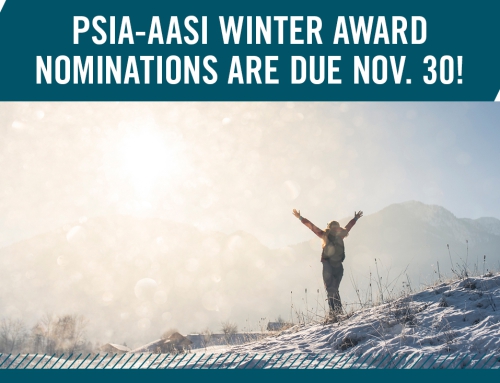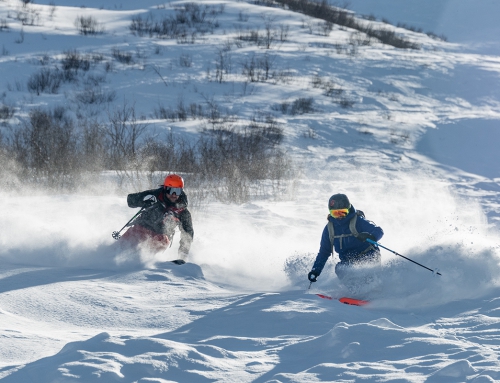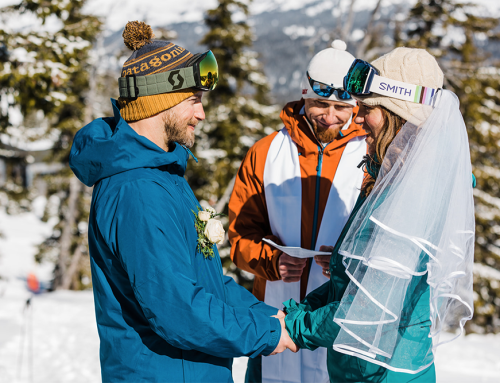32 Degrees: For Strong Telemark Turns, Don’t Rush the Finish
In this article, that appears in the spring 2022 issue 32 Degrees, Matt Charles shares how you can achieve stronger telemark turns this spring.
Telemark skiers love the dropped-knee position. It lowers your center of gravity closer to the snow, feels solid, and looks really cool in Instagram photos. The “telemark position” (as it’s called) offers stability through the end of the turn, where the lack of a heelpiece affects your ability to deal with natural turning forces. But for strong telemark turns, you’ll need to be solid in every part of the turn, including the trickiest one: the middle of the lead change, in (or around) the fall line.
Great ski instructors know the fall line is scary to people learning to slide on snow. As soon as skiers – alpine and tele alike – get into the fall line, they often try to get out of it as quickly as possible. It’s understandable, but it can lead to poor technical movements in the lower part of the turn. I often see skiers initiate rapid twisting actions, apply too much edge, or activate a “park-and-ride mode” until they can unfreeze themselves and move on to the next turn. These defensive actions can severely affect a skier’s ability to make a successful transition to the next turn.
Great telemark instructors know that one of the scariest parts of the lead change is the point where the feet pass each other. Most telemark skiers think of the familiar dropped-knee position as “safe,” and the farther away from that position they are the less safe they feel. Because of this perceived lack of stability, many telemark skiers rush through the matching portion of the turn and hasten the knee drop. This can lead to technique challenges, like the tele version of park-and-ride mode, where the skier locks into their dropped-knee position, doesn’t move, and just uses muscle strength to power through the terrain in front of them.
The difficult thing for telemark instructors is that these two scary moments often occur at almost the exact same time in your students’ turns. Just as people are rushing to get out of the fall line, they are rushing to make their feet pass more quickly so they can achieve the relative safety of the telemark position.
Fortunately, you can help your students avoid these errors by encouraging them to slow down, realize the strength of the “alpine position,” and focus on the fundamentals.
Fixate on These Telemark Fundamentals:
The Telemark Skiing Fundamentals offer the perfect framework to help your students put their fears behind them.
- Control the size, intensity, and timing of the lead change. In the context of this article, focus on timing. The telemark turn gives your students the freedom to speed up, or slow down, the lead change. A gradual, progressive lead change allows you to manage the forces of a turn without getting stuck in any one part of it. By keeping their feet moving, your students can maintain the ability to adapt to forces throughout the turn.
- Control the lateral relationship of the center of mass to the base of support to manage pressure from ski to ski. Two-footed skiing is great telemark skiing, but that doesn’t mean your students need to maintain exactly 50% of weight on each ski through all parts of the turn. For instance, after the fall line, while practicing gradual lead-change movements, have your students experiment by letting a little more pressure build on the outside ski, then take the energy gained from bending the ski and use it to transition into the next turn.
- Control edge angles through a combination of inclination and angulation. There is power in an edged ski. Whether edge angles are achieved by inclination, angulation, or a combination of both, an alpine-like position in the fall line (edged skis, near matching tips, body stacked) is a sturdy position that will serve your skiers well in (or around) the fall line.
When you teach your telemark students to slow down their lead change as they enter and exit the fall line, they won’t get stuck in tele park-and-ride, and they can maintain the constant movement that allows them to achieve the inimitable telemark flow. By encouraging them to think of the moment where their feet pass as “alpine position,” you can help them find new strength in a stance that works extremely well for our fixed-heel brethren. And if your students focus on the fundamentals, they’ll realize that if they control their edge angles and direct pressure toward the outside ski, they can be solid in every telemark position.
Help your telemark students approach the fall line and the lead change deliberately and with confidence. Trust me, it will look great on Instagram.
__
Matt Charles, who teaches at Plattekill Mountain in the Western Catskills of New York state, has earned his Telemark Level III and Alpine Level III certifications and Children’s Specialist 2 credential, and is a member of the Eastern Division Telemark Education Staff.







